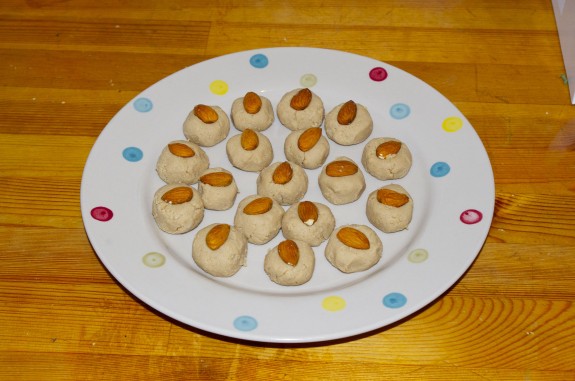CKP weddings were traditionally arranged by the parents of the bride and groom, who agreed upon the marriage mutually. Like many Hindu marriages today, this tradition has largely run its course – although arranged marriages are still practiced in the Indian CKP community.
View the rest of the CKP Wedding Guide:
Pre-Wedding/Engagement Rituals – You are here!
Sakarpuda
Pedas are a common featured mithai during the sakarpuda.
When the marriage is settled between both families, the bride’s side hosts an engagement ceremony, usually at the bride’s home. The bride and groom give each other packets of sweets (sakar means sugar in Marathi) to symbolize a sweet marriage and life together.
The bride and her parents sit on a wooden paat, or board, while the groom’s mother applies haldi to their foreheads and wishes them well by waving a holy candle over them. The groom’s mother presents the bride with the actual sakarpuda, a cone filled with pedas and other mithai, after the blessings.
Gharchaa Gadaganer
Two or three days before the wedding, both families meet for a lunch and get-together.
Gifts are exchanged between the families – these usually consist of clothing. The groom’s mother gifts the bride with a saree and blouse, which she changes into before completing the other rituals. She usually also gives the bride’s mother and sisters sarees as well. The groom’s father presents the bride’s father with a coconut and a gift as well.
The bride’s family accepts all these gifts and blessings by welcoming the groom into their lives. The bride’s mother places a kumkum tikka on the foreheads of the groom and his father and applies haldi to the hairline of the groom’s mother. The bride’s father usually also gives sweets or flowers to the groom.
Once the gifts, sweets, and well wishes are exchanged, the bride and groom exchange rings and are officially engaged. The ceremony is followed by a meal and more sweets, especially kheer, a vermicelli noodle pudding.
Muhurt Karane
A few days before the wedding, the bride’s elder female relatives (who are usually married) gather at the bride’s home to grind the haldi powder that is used during the haldi ceremony. This ceremony isn’t often practiced in modern times, because grinding haldi involves a pestile and lots of labor!
Haldi Kunku
The haldi ceremony at Preeti and Peter’s own wedding.
The haldi kunku ceremony is conducted with paste made from the muhurt ritual. The bride and groom each host their relatives in their own homes – the women go to the bride’s while the men attend to the groom.
The guests of honor sit on a chair or wooden paat while a short pooja is done. A mango leaf is then used to apply turmeric paste to the feet, hands, face, and shoulders of the bride and groom.
Once the bride is covered in haldi, her female relatives take turns helping her wash it off to reveal a bright, clean glow. Each of her elder married relatives throws cold water at her in turn, before she scrubs herself off completely. The bride’s mami (mother’s brother’s wife) gifts her an odd number of green bangles, which the bride wears throughout the wedding ceremony.
Some families practice the ceremonies with the bride and the groom in the same household, although traditionally this ceremony was conducted separately. Other modern traditions involve only the bride being covered in haldi.
After the haldi kunku, the bride and groom are not allowed to leave their respective homes until the day of the wedding.
Astrological Signs
Once the marriage is accepted by both the bride and groom’s sides of the family, the parents and elder relatives meet to discuss the details of the wedding ceremonies. These dates are selected based on the astrological signs of the bride and the groom. The birthdays of the bride and groom will determine which days in the Hindu calendar are auspicious for the wedding.


